
Researchers excavating the ancient Mayan city of Dzibanche, on Mexico’s border with Belize, have uncovered a rare set of stucco reliefs that shed light on one of the region’s powerful 1st millennia dynasties.
The Kaanu’l dynasty conquered and ruled over an area today comprising much of Mexico, Belize, and Guatemala between 250 and 650 C.E. As with all pre-Hispanic Mayan societies, the Kaanu’l believed they were the earthly representatives of the gods and took the snake as their symbol.
It was the presence of intertwined snakes in the imagery of the new stucco reliefs that allowed researchers to identify the dynasty as the force behind them. The three ancient artworks were found affixed to two platforms near an area used for a ball game, the likes of which were popular across much of the Mayan culture’s 3,000-year history. It’s believed the newly found Mayan reliefs date from between 500 and 600 C.E.
The discovery of the Mayan reliefs, which contain representations of ancestors, mythical animals. Photo: Gibrán Huerta. INAH.
The first scene shows a pair of guardians lined up beside a pedestal, which would have previously held a sculpture. Markings seem to indicate a specific Kaanu’l ruler, though researchers remain unclear which one. The second scene presents Kaanu’l ancestors who inhabit the night sky, a tableau filled with stars, snakes, and other classic Mayan icons. Here, too, there is a space where a sculpture would once have stood. The third scene is a mythological assemblage of animals, each one connected to a constellation in the sky.
“It’s a great find for us,” Sandra Balanzario, the lead archaeologist at Dzibanché, said in a statement. “Although we have stucco reliefs on larger buildings, we would never have thought of finding decorated façades of such significance on a ball court.”
The Kaanu’l believed they were the earthly representatives of the gods and took the snake as their symbol. Photo: Gibrán Huerta. INAH.
Finding and preserving Mayan reliefs has been one of the focus areas for the 100-person team that has been working inside the Archaeological Zone of Dzibanché since the end of 2023. Made of a lime gravel mixture called sascab, which the Maya used as mortar, the stuccos are vulnerable to weathering. Much of their vibrant original coloration has been lost. One initiative of researchers is to photograph the reliefs so that accurate photogrammetric models can be made.
Funding for the research has arrived through Mexico’s National Institute of Anthropology and History and Mayan Train, a project launched by former president Andrés Manuel López Obrador to build a 1,000-mile long railway network that loops together the nation’s Mayan sites.
To date, backing from these organizations has seen the restoration of Dzibanché’s Temple of the Owl, the Temple of the Cormorants, and a small acropolis, as well as explorations of the surrounding area.